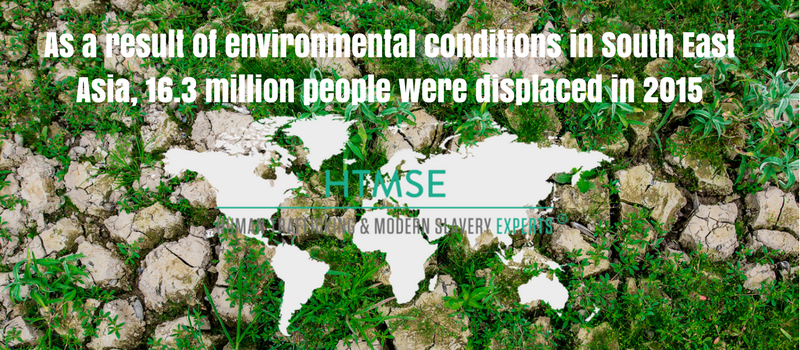
Climate change increases the likelihood of natural disasters, forces groups of people into migration or resettlement from their original territory, and leaves people homeless, which are all high risk circumstances for trafficking. Environmental conditions should be a key factor in assessing socio economic wellbeing and security of a group of people against displacement, and in turn exploitation.
In contrast to refugees of war where majority of people that have been migrating are of middle or upper class, when faced with environmental catastrophe they may be pushed into a position of desperation and share the vulnerabilities if the poor. Through a sudden disaster, people may be thrust straight into poverty if all their assets, property and potentially lives are lost as there is often no safety net for unpredicted catastrophes. This shock and rapid displacement of people often attracts new traffickers to the affected area or encourages systems and crime rings already in place. As people are heavily dependant on their surrounding environment, they are suddenly put into situations of desperation for work people become targets for labour abuse or slavery. There is also risk of people becoming involved in the trafficking itself as a way to make income. This of course perpetrates the issue while bolsters the trafficking business in a disaster stricken area.
In slow onset environmental changes, such as sea level rise or temperature change, a similar trend occurs when it leads to forced migration. Traffickers may look to regions where recourses may be scarce or environmental changes cause a change in labour demand. For example drought causes the movement away form agriculture and into more industry driven roles in urban areas, giving traffickers a window for recruitment. Furthermore significant trafficking is seen at host regions or places of settlement, such as in urban slums. Often with very minimal beginnings, little education, work experience in cities or knowledge of their rights, migrants are mislead by ‘agents’ into exploitative work.
Women, men and children all face different risks to environment induced migration. If hit by disaster, children may be orphaned and at high-risk without the care of their parents, as seen after the 2004 Ocean Tsunami in South East Asia as records of child ‘abductions’ in Indonesia were much higher. Women are most often recruited for domestic work or sexual exploitation whereas men are most often forced into labour in inhumane and exploitative conditions. Such work is often in poor environmental conditions, including recourse extraction and dealing with toxic substances, for example palm oil extraction in south East Asia. This constitutes an abuse of their human rights and furthermore contributes to the supply chain of industry pollutants that cause climate change.
To combat this issue, there needs to be acceptance of the link between these climate change, migration and trafficking. There is need for awareness to be raised and regulation in times of disaster and on going migration, as the IOM monitors trafficking rates through their Migrant Crisis Operational Framework. National policy should avoid restriction of the movement of people, because this will push traffickers further underground or into the black market where exploitation thrives. Environmental migration should be regulated as a coping mechanism for victims, which requires international cooperation.

